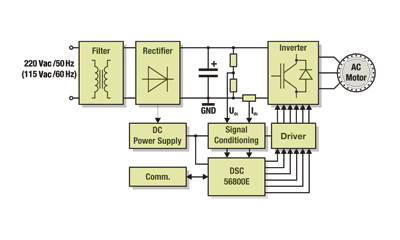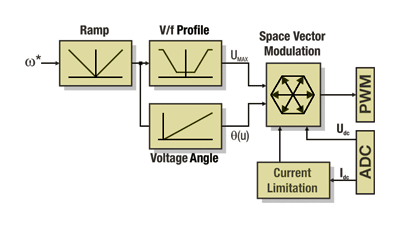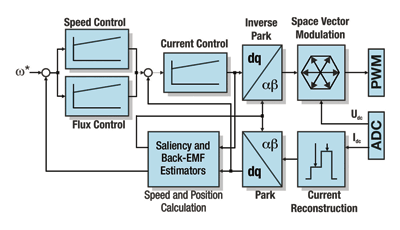Sensorless AC motor control improves efficiency
Digital signal controllers allow cost-effective energy reduction and performance improvement
BY PETER BALAZOVIC
Freescale Semiconductor
Roznov p.R., Czech Republic
http://www.freescale.com
Global demand for both energy and water conservation is having a tremendous impact on the home appliance market. The regulatory standards and recommendations are redefining a new generation of energy- and resource-efficient appliances, particularly washing machines, dryers, dishwashers, and refrigerators. To meet governmental regulations while still reducing system costs, appliance designers are using high-performance digital signal controllers (DSCs).
A DSC-based solution combines a digital signal processor’s processing power with an MCU’s functionality and ease of use on a single chip. Plus, a flexible set of peripherals makes it easy for designers to enable numerous functions. Employing variable-speed motor drives gives the designer an opportunity to use more sophisticated control programs and enhance appliance performance while increasing its energy efficiency.
The majority of electric motor drives in home appliances are controlled very simply by either fixing a constant motor speed or by running it directly from the AC main supply without additional control electronics. The AC mains-supplied single-phase induction motor (ACIM) is extensively used because it is low cost and reliable, but it also has lower efficiency and reduced speed control. Variable-speed drives address energy efficiency requirements by maintaining accurate speed control.
AC motor choice
ACIM, permanent magnet (PM) motors, or switched-reluctance motors can be used. For variable speed with an ACIM, variable frequency and voltage must be supplied, often referred to as constant-volt/Hz control. The ACIM speed drive efficiency can be improved using vector control that requires accurate velocity sensed by a speed or position sensor, but this can be costly and require lots of wiring.
Permanent magnet (PM) motors do not have to establish the flux using a stator winding. Replacing the electromagnetic excitation with permanent magnets has several advantages. Most obvious is the absence of excitation losses, which means PM motors have higher power density than comparable motors. Overall efficiency approaches 90% while single-phase ACIM efficiency reaches only about 70%. Permanently excited synchronous motors are very attractive solutions for home appliances, but they cannot be operated directly from the AC main supply.
Variable-speed motor drives
If electric motors are controlled to optimize the supplied speed/torque, the total power can be reduced by up to 30%. The controller for a variable-speed AC drive sets speed by regulating the frequency of the power supplied to the motor.
As Fig. 1 shows, the complete system for a variable-speed drive includes the EMI filter, the input rectifier, the on-board DC power supply, a DSC, the signal conditioning circuits, the power inverter, and the gate driver.

Fig. 1. A variable-speed drive uses a power inverter to set the drive frequency.
Motor control strategy
The open-loop scalar control is the most popular control strategy for variable-speed drives used with ACIM. Figure 2 shows scalar control of the drive frequency to the motor. Voltage magnitude is proportional to the voltage frequency. This technique requires modest computational power and can be handled by an 8-bit microcontroller.

Fig. 2. Vector control provides a simple method that does not need a rotation sensor.
The great advantage of this simple method is that it is sensorless and the control algorithm does not need information about the angular speed or actual rotor position. Speed dependence on the external load torque, however, is a big disadvantage, resulting in reduced dynamic performance. Because of this, electric motors under scalar control are oversized to deliver the required torque during load transients. In this control approach the energy efficiency might degrade down to the 50% range from a theoretical maximum.
Yet, market demands require the higher dynamic performance and operating speed range. Vector control (field-oriented control) of AC machines provides very good performance compared to scalar control. Vector control eliminates most of the disadvantages of constant volt/hertz control.


Fig. 3. Motor drive using vector control provides the highest dynamic performance and speed range.
The inner current loop calculates the direct and quadrature stator voltages required to create the desired torque and flux currents. The Park (dq/aß) functions transform these voltages into three-phase AC stator voltage demands in the stationary reference frame.
The motor currents are sinusoidal and produce smooth torque, which minimizes mechanical vibration and noise. The outer velocity loop adjusts the applied torque magnitude, which is directly proportional to quadrature torque-current and enables maintaining the required angular velocity. In order to effectively extend the operating speed range above base speed, an additional flux-weakening loop is added, which manipulates directional stator flux-current.
Sensorless control
To run an AC motor in vector-control mode you can synchronize the frequency of the applied voltage with the position of the rotor flux. Sensorless operation is essential where the speed and position calculation algorithm replaces a sensor. The sensorless control improves reliability and maintains high performance levels without extra cost. The system should be more accurate and efficient, smaller, lighter, less noisy, and have more advanced functionalities.
Sensorless algorithms can be broadly divided into two major groups-those that use magnetic rotor saliency for tracking rotor position and those that estimate rotor position from calculated motor models.
In a refrigerator, conventional control simply turns the compressor on and off to maintain the temperature in a predefined range. With sensorless PM motor control, the controller can accelerate the compressor to its target speed within a few seconds and can regulate speed to within ±1%. The smooth running of the compressor reduces audible noise, and the lower average operating speed helps minimize the temperature cycles, improving overall efficiency.
A washing machine operates in two basic cycles tumble-wash and spin-dry. During tumble-wash, the motor drive operates at low speed with high torque. During spin-dry, the motor drive works at high speed for short time periods. In newer models, the estimated speed ripples and calculated load torque provide valuable information on the washing load distribution. The speed ripple is used to estimate the load imbalance before starting the spin cycle. A variable speed motor can be used to regulate the clothes tub speed and direction to help correct the imbalance.
The application uses the A/D converter to digitize analog feedback signals (voltage, current). The A/D trigger is synchronized to the PWM reload flag, but the sampling time instances vary as a function of the actual PWM pattern. This configuration allows multiple conversions of the analog values for the DC-bus current and voltage within the one PWM cycle.
The PWM module can generate asymmetric PWM duty cycles in a center-aligned configuration, enabling three-phase current reconstruction in critical switching patterns. A flexible quad timer module in the DSC provides everything relating to time events. The application typically uses one channel for PWM-to-A/D converter synchronization and one for the system velocity control loop (1-ms period). The DSC can communicate with a front-panel master control over an isolated serial link. ■
Advertisement
Learn more about Freescale Semiconductor





